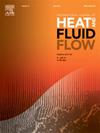跨声速翼型紊流控制的吹吸研究
IF 2.6
3区 工程技术
Q2 ENGINEERING, MECHANICAL
International Journal of Heat and Fluid Flow
Pub Date : 2025-02-17
DOI:10.1016/j.ijheatfluidflow.2025.109769
引用次数: 0
摘要
通过全面的参数化研究,研究了翼型可压缩湍流边界层壁面法向吹风和吸力的主动流动控制。研究了RAE2822跨声速翼型在吸力侧和压力侧不同位置的正吹或吸力对气动效率的影响。讨论了攻角、马赫数、控制幅度和控制位置对主动控制效果的影响。利用开源求解器SU2,利用reynolds -平均Navier-Stokes方程(RANS)对可压缩流进行了模拟。引入并计算了包括阻力和功率预算,以确定减少总阻力的控制配置,同时考虑了提供和倾倒控制流体的工作量。研究表明,在跨声速工况下,吸力侧的吸力具有很大的潜力,在所研究的参数范围内,总净阻力节省了16%。与先前的结果相反,吸力导致总阻力的减少,而吹气导致总阻力的增加。由于激波等非线性效应的出现,受到主动控制的强烈影响,导致其性能与以往主要考虑不可压缩流动的研究不同。本文章由计算机程序翻译,如有差异,请以英文原文为准。
Investigation of blowing and suction for turbulent flow control on a transonic airfoil
Active flow control of compressible turbulent boundary layers on airfoils via wall-normal blowing and suction is studied through a comprehensive parametric study. Wall-normal blowing or suction is applied in different positions on either the suction or pressure side of the transonic airfoil RAE2822 and its effect on the aerodynamic efficiency is investigated. The effect of the angle of attack, Mach number, control magnitude, and control position on the result of the active control are discussed. The compressible flow is simulated via Reynolds-averaged Navier–Stokes equations (RANS) with the open-source solver SU2. The inclusive drag as well as a power budget are introduced and calculated to determine the control configurations that decrease the total drag also accounting for the effort to provide and dump the control fluid. The study shows the promising potential of suction on the suction side in the transonic regime where total net drag savings of 16% were achieved in the investigated parameter range. Contrary to previous results, suction leads to a decrease in the total drag, whereas blowing leads to an increase. The appearance of non-linear effects as the shock wave, which is strongly influenced by the active control, contributes to the different performance compared to previous studies, which mostly considered incompressible flows.
求助全文
通过发布文献求助,成功后即可免费获取论文全文。
去求助
来源期刊

International Journal of Heat and Fluid Flow
工程技术-工程:机械
CiteScore
5.00
自引率
7.70%
发文量
131
审稿时长
33 days
期刊介绍:
The International Journal of Heat and Fluid Flow welcomes high-quality original contributions on experimental, computational, and physical aspects of convective heat transfer and fluid dynamics relevant to engineering or the environment, including multiphase and microscale flows.
Papers reporting the application of these disciplines to design and development, with emphasis on new technological fields, are also welcomed. Some of these new fields include microscale electronic and mechanical systems; medical and biological systems; and thermal and flow control in both the internal and external environment.
 求助内容:
求助内容: 应助结果提醒方式:
应助结果提醒方式:


